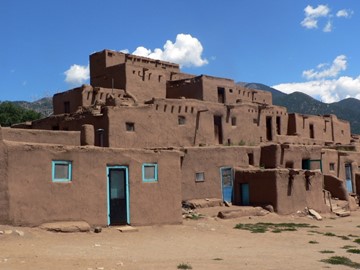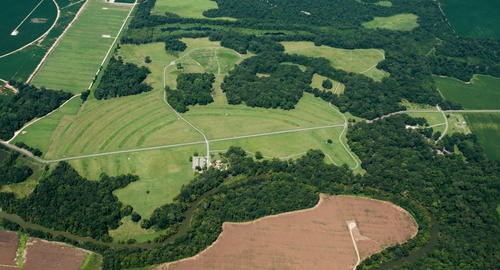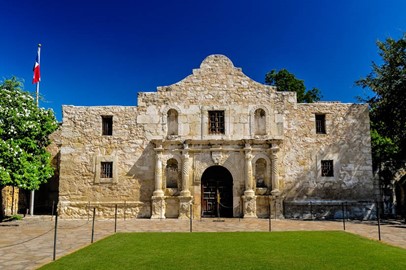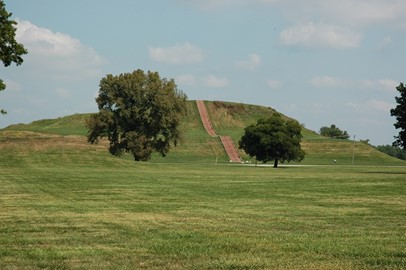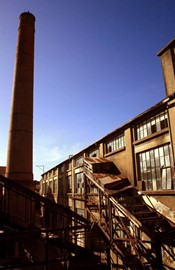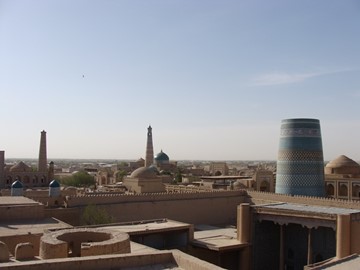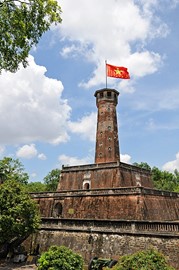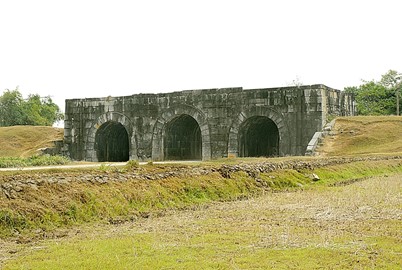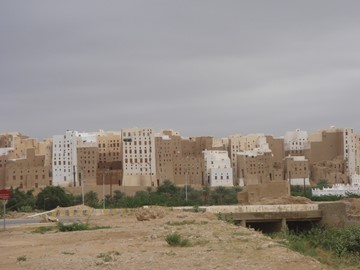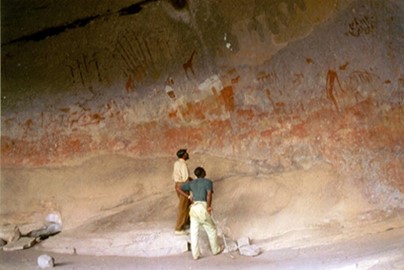category :: cultural
Chaco Culture
Chaco Culture, a UNESCO World Heritage site in the United States, preserves an ancient Puebloan civilization that thrived between 850 and 1250 AD. This remarkable archaeological site showcases monumental public and ceremonial buildings, including massive stone structures known as 'great houses,' which demonstrate advanced architectural and astronomical knowledge. The site's intricate road systems and cultural artifacts highlight its significance as a major center of ancestral Puebloan society, offering valu... Read More
Taos Pueblo
Taos Pueblo, a UNESCO World Heritage site in the United States, is an ancient Native American community renowned for its multi-storied adobe buildings, which have been continuously inhabited for over 1,000 years. This living village, constructed from sun-dried mud bricks, exemplifies the architectural ingenuity and cultural traditions of the Pueblo people. Its historical significance and well-preserved structures make it a remarkable testament to indigenous heritage and resilience.
Poverty Point
The Monumental Earthworks of Poverty Point, a UNESCO World Heritage Site in the USA, is a prehistoric complex built by a hunter-fisher-gatherer society between 1700 and 1100 B.C.E. It features five mounds, six concentric semi-elliptical ridges, and a central plaza, representing a remarkable feat of earthen construction unmatched in North America for over 2,000 years. This site, created without modern tools or agriculture, highlights the sophistication of its builders and their extensive trade network across... Read More
San Antonio Missions
The San Antonio Missions, a UNESCO World Heritage site in the United States, comprise a group of five colonial-era missions established by Spanish Catholic missionaries in the 18th century. These missions, including the famous Alamo, were built to spread Christianity and Spanish culture among the indigenous populations, featuring distinctive stone churches, living quarters, and agricultural systems. Today, they stand as well-preserved historical landmarks, offering insight into the region’s colonial past an... Read More
Monticello
Monticello and the University of Virginia, a UNESCO World Heritage site in the United States, represent exceptional examples of neoclassical architecture designed by Thomas Jefferson, the third U.S. President. Monticello, Jefferson’s self-designed home, showcases his innovative ideas with features like the octagonal dome and sustainable estate planning. The University of Virginia, founded by Jefferson in 1819, integrates a unique “academical village” layout, blending student living and learning spaces with ... Read More
Cahokia Mounds
Cahokia Mounds, a UNESCO World Heritage Site in the United States, is a remarkable pre-Columbian Native American city that flourished between 1050 and 1350 CE. At its peak, it was one of the largest urban centers north of Mexico, featuring over 120 earthen mounds, including the impressive Monks Mound, the largest prehistoric earthwork in the Americas. The site served as a hub for trade, religion, and culture, with evidence of a sophisticated society that included planned settlements, agricultural innovation... Read More
La Fortaleza and San Juan
La Fortaleza and San Juan, a UNESCO World Heritage site in the Puerto Rico, is a historic fortified complex and colonial city renowned for its well-preserved Spanish architecture and military engineering. Established in the 16th century, it includes La Fortaleza, the governor’s residence, and formidable structures like Castillo San Felipe del Morro, reflecting its strategic role in the Caribbean. The site showcases over 500 years of history, blending cultural influences and offering a glimpse into colonial ... Read More
Colonia del Sacramento
Colonia del Sacramento, a UNESCO World Heritage site in Uruguay, is a charming historic town founded by the Portuguese in 1680. Known for its well-preserved colonial architecture, cobblestone streets, and picturesque waterfront along the Río de la Plata, it offers a glimpse into the region’s past as a contested settlement between Spanish and Portuguese powers. Key landmarks include the iconic lighthouse, the Basilica of the Holy Sacrament, and remnants of ancient fortifications, making it a cultural treasur... Read More
Fray Bentos Industrial Landscape
The Fray Bentos Industrial Landscape, a UNESCO World Heritage site in Uruguay, is a historic industrial complex established in 1859 along the Uruguay River. It showcases the complete meat production process—from sourcing and processing to packing and dispatching—featuring the Liebig Extract of Meat Company’s facilities (starting in 1865) and the Anglo Meat Packing Plant (from 1924), which supplied meat extract, corned beef, and frozen meat to global markets. This site highlights the technological and cultur... Read More
Itchan Kala
Itchan Kala, a UNESCO World Heritage site in Uzbekistan, is the historic inner town of Khiva, encircled by towering brick walls that once sheltered caravans before their desert journey to Iran. This well-preserved gem showcases Central Asian Islamic architecture with notable structures like the Djuma Mosque, ornate mausoleums, and grand palaces from the 19th century, reflecting its rich cultural legacy. Recognized in 1990, it stands as a testament to the region’s historical significance along the Silk Road.... Read More
Samarkand
Samarkand, a UNESCO World Heritage site in Uzbekistan, is a historic city renowned for its stunning Islamic architecture and rich cultural legacy. Known as a crossroads of ancient trade routes, it features iconic landmarks like the Registan, a grand public square framed by intricately tiled madrasas, and the Bibi-Khanym Mosque, famed for its colossal dome. The city’s mausoleums, such as the Gur-e-Amir, showcase exquisite craftsmanship and house the tombs of notable figures, reflecting its significance as a ... Read More
Shakhrisyabz
The Historic Centre of Shakhrisyabz, a UNESCO World Heritage site in Uzbekistan, is an ancient city along the Silk Road, renowned for its cultural and political significance during the 14th and 15th centuries under the Timurid Empire. It features exceptional monuments, including the grand ruins of the Ak-Saray Palace and the Kok-Gumbaz Mosque, showcasing Timurid architectural brilliance. As the birthplace of Amir Timur (Tamerlane), it reflects centuries of secular development, though it has been listed as a... Read More
Bukhara
The Historic Centre of Bukhara, a UNESCO World Heritage site in Uzbekistan, is a remarkably well-preserved example of a Central Asian Islamic city, showcasing over a thousand years of history. Its architectural treasures include the ancient Ark Fortress, the intricately designed Kalon Minaret, and numerous mosques, madrasas, and mausoleums reflecting the city’s role as a major Silk Road hub. This living museum highlights Bukhara’s cultural and religious significance, with its traditional bazaars and labyrin... Read More
Chief Roi Mata’s Domain
Chief Roi Mata’s Domain, Vanuatu’s first UNESCO World Heritage site, inscribed in 2008, encompasses sites linked to the life and death of the last paramount chief, Roi Mata, from the early 17th century. This cultural landscape reflects his enduring legacy of social reforms and conflict resolution, preserved through oral traditions and archaeological evidence. The site, under traditional and legal protection, remains significant to local communities, who maintain its integrity and offer cultural tours to edu... Read More
Coro
Coro and its Port, located in northwestern Venezuela, is a UNESCO World Heritage site recognized for its unique earthen architecture and historical significance. Founded in 1527, it showcases a remarkable blend of local traditions with Spanish Mudéjar and Dutch architectural techniques, evident in its well-preserved colonial buildings and original street layout. As one of the first colonial towns in Latin America, it served as Venezuela’s initial capital and the continent’s first bishopric. Since 2005, it h... Read More
Ciudad Universitaria de Caracas
Ciudad Universitaria de Caracas, a UNESCO World Heritage site in Venezuela, is a remarkable example of modernist architecture designed by Carlos Raúl Villanueva. Completed between the 1940s and 1960s, it serves as the main campus of the Central University of Venezuela, blending functional buildings with open plazas, lush gardens, and striking artworks. Its innovative design and cultural significance earned it global recognition as a masterpiece of urban planning and architectural creativity.
Hué
The Complex of Hué Monuments, a UNESCO World Heritage Site in Vietnam, showcases the grandeur of the Nguyen Dynasty, which ruled from 1802 to 1945. This historic ensemble includes the fortified Citadel, the Imperial City, and the Forbidden Purple City, along with royal tombs, temples, and pagodas, all harmoniously integrated with the natural landscape. Recognized in 1993, it exemplifies eastern feudal architecture and urban planning, reflecting Vietnam’s rich cultural and political heritage. Despite wartime... Read More
Hoi An
Hoi An Ancient Town, a UNESCO World Heritage site in Vietnam, is a remarkably well-preserved trading port dating back to the 15th century. Known for its blend of local and foreign architectural influences, the town features narrow streets lined with colorful lanterns, historic wooden buildings, and ornate temples. Once a bustling hub for merchants from China, Japan, and Europe, it now thrives as a cultural landmark, offering a glimpse into its rich past through its timeless charm and serene riverside settin... Read More
My Son
My Son, a UNESCO World Heritage Site in Vietnam, is a remarkable collection of ancient Hindu temples built by the Champa Kingdom between the 4th and 13th centuries. Dedicated primarily to the deity Shiva, the site features intricately carved red-brick towers that reflect a unique blend of Indian and local architectural influences. Despite damage from time and conflict, including the Vietnam War, its well-preserved ruins offer a vivid glimpse into the spiritual and cultural history of the Cham civilization. ... Read More
Hanoi Citadel
The Imperial Citadel of Thang Long - Hanoi, a UNESCO World Heritage site in Vietnam, is a historic fortress that served as the political and military center of the region for over a thousand years. Originally built in the 11th century during the Ly Dynasty, it showcases a blend of architectural styles reflecting its evolution through various ruling eras. Today, it stands as a significant cultural landmark, housing archaeological remains, ancient structures, and museums that offer insights into Vietnam’s ric... Read More
Citadel of the Ho Dynasty
The Citadel of the Ho Dynasty, a UNESCO World Heritage site in Vietnam, is a remarkable 14th-century fortress built during the short-lived Ho Dynasty. Constructed in 1397 using large stone blocks, it showcases advanced architectural techniques and reflects the influence of Confucian urban planning. The citadel served as the political, economic, and cultural center of the dynasty until its fall in 1407. Today, it stands as a well-preserved testament to Vietnam’s historical and cultural legacy.
Shibam
The Old Walled City of Shibam, a UNESCO World Heritage site in Yemen, is renowned for its unique 16th-century architecture featuring tall mudbrick towers, earning it the nickname 'Manhattan of the Desert.' This ancient city showcases an exceptional example of urban planning, with its densely packed, multi-story buildings constructed from sun-dried mud bricks, designed to maximize space and provide defense. Its historical significance lies in its well-preserved state, reflecting traditional building techniqu... Read More
Sana'a
The Old City of Sana'a, a UNESCO World Heritage site, is renowned for its unique architecture featuring multi-story tower houses made of rammed earth and decorated with intricate geometric patterns. This historic city, inhabited for over 2,500 years, showcases a rich cultural legacy with its ancient mosques, bustling souks, and traditional hammams. Its preservation reflects Yemen's historical significance as a center of trade and Islamic scholarship.
Zabid
The Historic Town of Zabid, a UNESCO World Heritage Site in Yemen, is renowned for its exceptional domestic and military architecture, reflecting its significance as a political and cultural hub from the 13th to 15th centuries. Once a thriving center of Islamic learning, it boasts the highest concentration of mosques in Yemen, including the prominent Great Mosque, alongside vestiges of its historic university. Designated in 1993, Zabid was added to the List of World Heritage in Danger in 2000 due to deterio... Read More
Matobo Hills
The Matobo Hills, a UNESCO World Heritage site in Zimbabwe, is a striking cultural landscape renowned for its dramatic granite rock formations and ancient rock art. Formed over 2 billion years ago, the hills feature unique kopjes and boulders that have sheltered human communities since the Stone Age, leaving behind a rich legacy of paintings dating back 13,000 years. This site also holds deep spiritual significance, tied to the Mwari religion, and showcases a blend of natural beauty and historical importanc... Read More

